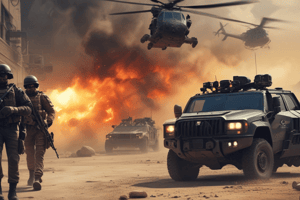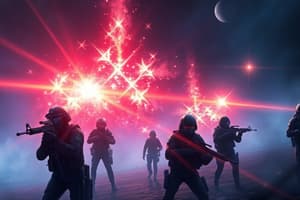Podcast
Questions and Answers
What did Radley Balko primarily focus on in his paper that was not mentioned by Christopher Cooper?
What did Radley Balko primarily focus on in his paper that was not mentioned by Christopher Cooper?
- Follow-up investigations of felony narcotics arrests
- Seizures and forfeitures related to drug activity
- No-knock or quick-knock SWAT raids used for drug raids (correct)
- Street-level undercover work by pro-active squads
What did Balko ignore in his paper, as mentioned in the text?
What did Balko ignore in his paper, as mentioned in the text?
- Obtaining controlled substances by fraud and the diversion of legal drugs
- Clandestine drug laboratory raids and street narcotics investigations through the use of informants (correct)
- Forged prescriptions and illegal distribution of pharmaceuticals
- 1.5 million other drug arrests occurring each year by patrol officers or narcotics detectives
What is the nature of the undercover work done by pro-active squads as described in the text?
What is the nature of the undercover work done by pro-active squads as described in the text?
- They work in uniform with a badge and vest
- They primarily focus on high-level drug dealers
- They work without backup nearby
- They work in street clothes with a gun but no badge or vest, dealing with strangers with backup a football field away (correct)
What risk do undercover officers in street-level narcotics investigations face according to the text?
What risk do undercover officers in street-level narcotics investigations face according to the text?
What was the total value of the equipment distributed by the military to police agencies by 2005?
What was the total value of the equipment distributed by the military to police agencies by 2005?
In 1997 and 1998, how many orders of Pentagon equipment were handled by the new military agency from U.S. police agencies?
In 1997 and 1998, how many orders of Pentagon equipment were handled by the new military agency from U.S. police agencies?
What was the total number of agencies requesting equipment by 2005?
What was the total number of agencies requesting equipment by 2005?
In 2011, how much did the Department of Homeland Security give in grants to local police departments?
In 2011, how much did the Department of Homeland Security give in grants to local police departments?
What did the Sheriff’s Department of Marion County, Florida acquire from the military according to the text?
What did the Sheriff’s Department of Marion County, Florida acquire from the military according to the text?
What percentage of call-outs for a SWAT team was analyzed for five departments from 2009 to 2013?
What percentage of call-outs for a SWAT team was analyzed for five departments from 2009 to 2013?
How many warrant service activations were there for the SWAT team for each department per year based on the study from 2009 to 2013?
How many warrant service activations were there for the SWAT team for each department per year based on the study from 2009 to 2013?
What was the average number of calls for the five departments surveyed from 2009 to 2013?
What was the average number of calls for the five departments surveyed from 2009 to 2013?
How many subjects were struck by at least one bullet fired by a SWAT officer based on Klinger and Rojek's data?
How many subjects were struck by at least one bullet fired by a SWAT officer based on Klinger and Rojek's data?
How many suspects took their own lives during SWAT operations based on direct or extrapolated data?
How many suspects took their own lives during SWAT operations based on direct or extrapolated data?
What did Klinger and Rojek conclude about SWAT shootings based on their data?
What did Klinger and Rojek conclude about SWAT shootings based on their data?
What was the composition of the SNEU teams?
What was the composition of the SNEU teams?
What was the role of informants in narcotics enforcement?
What was the role of informants in narcotics enforcement?
What was the responsibility of SWAT teams during drug raids?
What was the responsibility of SWAT teams during drug raids?
What was the purpose of no-knock raids in narcotics enforcement?
What was the purpose of no-knock raids in narcotics enforcement?
How did the American public's support for the war on drugs change over the years according to Gallup polling?
How did the American public's support for the war on drugs change over the years according to Gallup polling?
How did attitudes toward marijuana legalization change over time according to Gallup polling?
How did attitudes toward marijuana legalization change over time according to Gallup polling?
What was the primary cause of injuries or fatalities in raids on wrong addresses, as argued by Balko (2006)?
What was the primary cause of injuries or fatalities in raids on wrong addresses, as argued by Balko (2006)?
What did Klinger and Rojek (2008) find to be the average number of warrants served per year by a SWAT team?
What did Klinger and Rojek (2008) find to be the average number of warrants served per year by a SWAT team?
Which type of warrants were described as the 'bread and butter' of SWAT work?
Which type of warrants were described as the 'bread and butter' of SWAT work?
What is considered the best procedure for a drug raid, according to the text?
What is considered the best procedure for a drug raid, according to the text?
What has been the trend in the prevalence of SWAT teams since the 1960s?
What has been the trend in the prevalence of SWAT teams since the 1960s?
What did Congress pass to enhance cooperation between police and military, according to the text?
What did Congress pass to enhance cooperation between police and military, according to the text?
What are SWAT teams established for?
What are SWAT teams established for?
What did Klinger and Rojek find about the average number of warrants served per year by a SWAT team?
What did Klinger and Rojek find about the average number of warrants served per year by a SWAT team?
What techniques do SWAT teams use for raids, according to the text?
What techniques do SWAT teams use for raids, according to the text?
What was the composition of SWAT teams during drug raids according to the text?
What was the composition of SWAT teams during drug raids according to the text?
What do narcotics warrants constitute for SWAT work?
What do narcotics warrants constitute for SWAT work?
What is considered rare according to the text?
What is considered rare according to the text?
Flashcards are hidden until you start studying
Study Notes
-
Edward Conlon, a New York City Police Department narcotics officer, detailed his experiences with the Street Narcotics Enforcement Unit (SNEU) in the South Bronx.
-
SNEU teams consisted of a sergeant and 5-10 officers, with an observation post (OP) and a catch car.
-
OP officers observed drug transactions from rooftops or vacant apartments, then radioed descriptions to the catch car for arrests.
-
Drug sets ranged from small-time operations to complex organizations with various roles.
-
Informants, often drug users, played a key role in gathering information for raids. Their information had to be carefully evaluated.
-
Surveillance was a crucial part of narcotics enforcement, involving long hours on rooftops and careful planning.
-
SWAT teams were responsible for securing occupants and evidence during raids, turning the scene over to narcotics detectives once secured.
-
No-knock raids were conducted to prevent drugs from being flushed down the toilet during a regular search warrant wait.
-
The American public's support for the war on drugs remained strong, with attitudes on drug use changing little over the years except for marijuana legalization.
-
Gallup polling showed that 83% of the public saw the drug problem as extremely or very serious in 2000, 68% in 2009, and 71% in 2017.
-
Attitudes toward marijuana legalization saw a dramatic shift, with 84% feeling it should be illegal in 1970, over 70% until the mid-1990s, and 64% feeling it should be legal in 2017.
-
Balko (2006) argued that hundreds of raids are conducted on the wrong address each year, leading to injuries or fatalities.
-
Poor police work by narcotic detectives was the cause.
-
SWAT teams were established for unusual and dangerous situations, like barricaded subjects and hostage incidents.
-
However, these incidents are rare.
-
Klinger and Rojek (2008) found that the average number of warrants served per year by a SWAT team was 14.
-
Narcotics warrants were the "bread and butter" of SWAT work.
-
SWAT teams use various techniques for raids, such as surrounding the location, dynamic entry, breach and pull back, and breach and hold.
-
The best procedure for a drug raid is to have surveillance of the location for 24 hours in advance.
-
Since the 1960s, SWAT teams have become increasingly common in cities, suburbs, and even small towns.
-
In response to the war on drugs, Congress passed several laws that enhanced cooperation between the police and military, including the transfer of military equipment to the police.
Studying That Suits You
Use AI to generate personalized quizzes and flashcards to suit your learning preferences.




